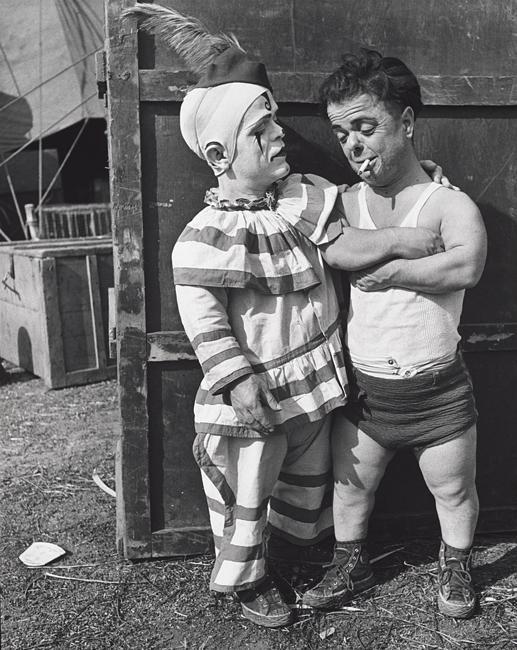John Gutmann
John Gutmann, Two Midget Clowns Backstage, 1940. John Gutmann Archive.
© 1998 Center for Creative Photography, Arizona Board of Regents. 2000.112.32
John Gutmann (1905–1998) was one of America’s most distinctive photographers. Born in Germany where he trained as an artist and art teacher, he fled the Nazis in 1933 and settled in San Francisco, reinventing himself as a photo-journalist. Gutmann captured images of American culture, celebrating signs of a vibrant democracy, however imperfect. His own status as an outsider—a Jew in Germany, a naturalized citizen in the United States—informed his focus on individuals from the Asian-American, African-American, and gay communities, as well as his photography in India, Burma, and China during World War II. Gutmann’s interests in painting and filmmaking, his collections of non-Western art and artifacts, and his pedagogy, all figure in a body of work at once celebratory and mysterious.
Gutmann was born to prosperous German-Jewish parents, in Breslau, Germany (since 1945, Wrocław, Poland). At age twenty-two, he graduated from the regional Academy of Arts and Crafts, where he studied with leading Expressionist painter Otto Müller. In 1927 Gutmann moved to Berlin, where he taught art to schoolchildren, participated in group exhibitions, and in 1931 had a solo show at the prestigious Gurlitt Gallery. However, his career was interrupted by the rise to power of the National Socialists in early 1933. While his family made plans to immigrate to New York, Gutmann set out on his own with San Francisco as his destination, and photography as his new profession. Before departing Germany, he acquired a Rolleiflex camera, hastily shot three rolls of film, and managed to secure a contract from the Berlin office of Presse-Photo. Making the most of a bad situation, he explored a new life as a foreign correspondent who would supply the very modern European illustrated press with views and reports from the American West.
By 1936, he had broken his contract with the Berlin press agency and made a new one with Pix in New York. By 1937, he had begun to teach art regularly at San Francisco College (later San Francisco State University), and this became his primary profession after a World War II era stint in the U.S. army. Gutmann retired his professorship in 1973 and began to reassess his body of work, sorting through boxes of negatives and making new prints of selected examples from the 1930s. It was a well-timed exercise: not only did Gutmann’s images satisfy a growing historical appetite for Depression-era photography, they also seemed compatible with certain kinds of experimental photography then emerging in the contemporary art scene. Before his death in 1998, Gutmann had seen his work featured in gallery and museum exhibitions, catalogues, and monographs.
By bequeathing his rich archive of nearly 5000 modern photographic prints, negatives, tearsheets, letters, and some drawings and early art prints to the CCP, John Gutmann has left us with the task of pursuing the rich knots, braids, tangles and threads in his complex life and work that unfolded over a most tumultuous and provocative century of modernity.


